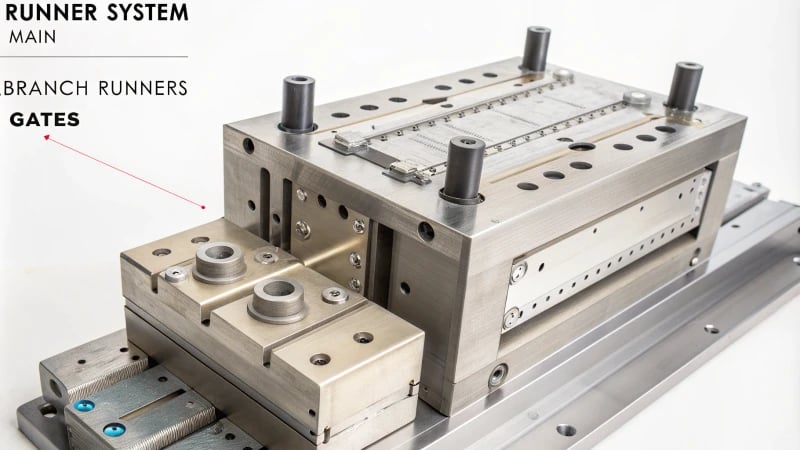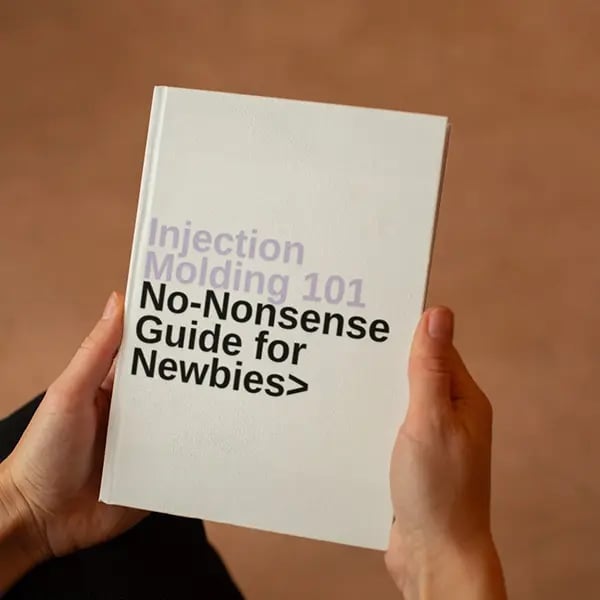
Do you ever wonder about the creation of your favorite plastic items? It feels like magic. However, there is a really interesting science behind it!
The runner in a plastic mold is a channel system guiding plastic melt from the injection molding machine to the mold cavity, including the main runner, branch runner, and gate, ensuring smooth and efficient molding.
When I started learning about injection molding, I found out that the runner is essential. This smart little channel directs the melted plastic from the machine into the mold. Every part of the runner system matters. The main runner and the gate are very important. They help the plastic flow smoothly and evenly. It’s like a river finding its path. Knowing these parts has changed how I see product design. My views on design have really transformed.
The runner is essential for efficient plastic molding.True
Runners are crucial for directing molten plastic to mold cavities, ensuring smooth processes and high-quality products.
Runners do not affect the quality of molded plastic products.False
Runners play a critical role in the molding process, directly influencing the quality of the final product.
What are the different types of runners in injection molding?
Have you ever felt confused by the complex world of injection molding? Designers consider understanding runner types as crucial. So, what really sets cold runners apart from hot ones? Let’s explore this topic together!
Injection molding uses two runner types: cold runners, where plastic cools before entering the mold, and hot runners, which keep plastic molten until reaching the cavity, affecting cycle time and product quality.

Understanding Runners in Injection Molding
When I first joined the world of injection molding, I felt confused by all the technical words. When I learned about runners, I saw how vital they are to the process. Runners carry the plastic from the machine’s nozzle to the mold cavity. Everything flows smoothly with their help. Two main types exist: cold runners and hot runners. Each type has unique features for various manufacturing needs.
Cold Runners
Cold runners are like reliable, old friends in injection molding. They work at normal temperatures, letting the plastic cool before entering the mold cavity. I once worked on a project with cold runners. They were straightforward, but we watched the cooling times carefully to avoid problems.
Advantages of Cold Runners:
- Simplicity: The simple design leads to lower manufacturing costs. Lower costs are always pleasant.
- Material Savings: Leftover plastic can be reprocessed and reused. They are probably more eco-friendly.
Disadvantages of Cold Runners:
- Cycle Time: They can slow production because cooling takes time. This delay can affect deadlines. Be aware of this!
- Quality Impact: Poorly designed cold runners might cause defects like flow marks. Pay attention to every detail.
Hot Runners
Hot runners are more high-tech and remind me of a friend with the latest gadgets. Heated channels keep the plastic molten until it reaches the mold cavity. Results are often impressive.
Advantages of Hot Runners:
- Reduced Cycle Time: Heated material speeds up production greatly. Fast production really changes project timelines.
- Improved Quality: Fewer defects mean fewer quality control issues.
Disadvantages of Hot Runners:
- Higher Initial Cost: The complexity increases costs. I often have to explain these costs in meetings.
- Material Limitations: Some materials don’t work well with hot runners. Sometimes, you need the right ingredients, like with frozen bananas in a smoothie.
Comparative Table of Runner Types
| Feature | Cold Runner | Hot Runner |
|---|---|---|
| Temperature | Ambient | Heated |
| Cycle Time | Longer | Shorter |
| Cost | Lower | Higher |
| Waste Management | More waste due to cooling | Less waste, recyclable runners |
| Product Quality | Potential defects | Higher quality |
Understanding these differences really influenced my design choices. Knowledge of how runners impact production and the final product is valuable. For those wanting to improve runner designs further, check out best practices1 to possibly elevate your injection molding skills!
Cold runners increase cycle time in injection molding.True
Due to cooling, cold runners may extend cycle times, affecting production efficiency.
Hot runners reduce product quality in injection molding.False
Hot runners maintain material temperature, improving quality and minimizing defects during injection molding.
How does runner design impact the injection molding process?
Have you wondered how a small design decision changes everything in manufacturing? Runner design greatly affects the injection molding process. This is very crucial for product quality and efficiency.
Runner design in injection molding directs material flow and manages temperature and pressure, significantly affecting the final product’s quality and appearance.

Definition and Location of Runners
When I began studying injection molding, I was amazed to find that the runner is like a hidden hero of the process. This important path carries the plastic melt from the machine’s nozzle to the mold cavity.
Typically, the runner is on the mold’s parting surface. It has three main parts: the main runner, the branch runner, and the gate. Learning about these parts was truly eye-opening for me.
- Main Runner: This is like a major vein. It links the nozzle to the branch runner. A well-thought-out main runner is key for smooth plastic flow into the mold.
- Branch Runner: It sends the melt to each gate. I recall dealing with various shapes – circular, semicircular, and trapezoidal – and each influenced fluidity and pressure. It seemed like solving a puzzle sometimes!
- Gate: The gate is the last section before the melt enters the mold cavity. Its design significantly impacts flow and product quality.
Grasping these parts is crucial if you wish to perfect your injection molding process. This helps in achieving better product quality.
Function and Importance of Runner Design
I’ve found that the design of the runner system is very important for many reasons:
- Guiding Melt Flow: The runner acts as a path leading melt into the mold cavity effectively. For instance, with a project that had multiple cavities, I saw how a good runner spread melt evenly. Each cavity got filled perfectly.
| Runner Type | Description | Advantages |
|---|---|---|
| Main Runner | First channel from nozzle | Smooth transition of melt |
| Branch Runner | Distributes melt to gates | Equal filling across multiple cavities |
| Gate | Connects runner to cavity | Affects quality and aesthetics |
-
Controlling Temperature and Pressure: Shape and size really matter in temperature and pressure changes during flow. For example, I noticed that a shorter and wider runner helped reduce pressure loss. Materials with thermal insulation kept the melt temperature stable.
-
Affecting Product Quality and Appearance: The design of gates greatly affects the final product. In a project with high beauty needs, pinpoint gates were perfect as they left tiny marks. For another job, latent gates were removed during demolding, leaving no marks!
These experiences truly showed me how runner design is crucial not only for functionality but also for how molded parts look.
Conclusion on Runner Design Impact
In conclusion, I learned that runner design is not only a technical detail; it decides how well a mold fills and the product’s quality. By understanding and using good runner systems, production efficiency and product excellence increase. If you want to take your injection molding process higher, explore advanced runner systems2 for more knowledge on effective designs that can greatly improve your manufacturing skills.
Runner design affects melt flow efficiency in injection molding.True
A well-designed runner ensures smooth melt flow, improving filling efficiency and reducing pressure loss during the injection molding process.
Gate design has no impact on product quality in molding.False
Gate design directly influences the final product's quality and appearance, making it crucial for achieving desired aesthetics.
How Do Temperature and Pressure Influence Runner Functionality in Plastic Molding?
Have you ever thought about how simple things like temperature and pressure really change how runner systems work in plastic molding? Let’s explore this topic and understand its details together.
Temperature and pressure are crucial in plastic molding, impacting melt thickness, flow, and ultimately product quality. Optimal control ensures high-quality injection molded products.

Understanding Runner Functionality in Molding
When I first entered the field of plastic injection molding, I felt truly amazed by the runner system’s vital importance in production. Picture it as a smooth dance, leading the plastic melt from the nozzle to the mold cavity. Temperature and pressure control this process, keeping everything running smoothly. They really matter.
Key Components of Runner Systems:
- Main Runner: This main path connects the injection machine’s nozzle to the branch runner. It must be designed to reduce pressure loss and allow a smooth transition.
- Branch Runner: Here, the branch runner spreads the melt evenly to each gate, affecting flow rate and temperature. It acts like directing traffic efficiently.
- Gate: As the entrance to the mold cavity, it controls how the melt enters. Good design here greatly improves product quality. Very important.
The Role of Temperature
Temperature fascinates me because it affects the viscosity of the plastic melt. This decides how easily it flows through the runner system. In a past project, we faced blockages. Controlling the temperature solved the problem. Important points about temperature:
- The melt keeps optimal fluidity, reducing blockage risk.
- The cooling rate stays controlled, preventing issues like early solidification.
Factors Influencing Temperature Control
| Factor | Impact |
|---|---|
| Environmental Conditions | Changes in ambient temperature can affect processing; I must adjust based on seasons. |
The Influence of Pressure
Pressure is also crucial in filling the mold effectively with plastic melt. High pressure during injection overcomes resistance in the runner. It ensures:
- Fast mold filling, essential for detailed designs.
- Proper material packing, reducing defects and maintaining quality.
Pressure Management Techniques
- Runner Design: Optimizing runner size and length has helped me decrease pressure drop.
- Injection Speed: Adjusting speed maintains stable pressure, improving results.
Interaction Between Temperature and Pressure
Balancing temperature and pressure is vital for good runner function. If they don’t align, issues arise. Lower temperatures increase viscosity, demanding more pressure. Higher temperatures might cause material breakdown. This balance needs constant care.
Practical Applications and Considerations
When designing runners for specific products, several things come to mind:
- Material Selection: Each plastic type has unique temperature and pressure needs. I research material behavior under various conditions. This research is very helpful here3.
- Mold Design: The layout of gates and runners affects flow and cooling, impacting product quality. For mold design tips, I refer to this resource4.
Understanding temperature and pressure’s impact on runner function has been crucial in improving my production and achieving excellent plastic parts. For more on this, explore heat effects on performance5. I hope my experiences help you in your journey with plastic molding!
Temperature affects the viscosity of plastic melts in molding.True
Higher temperatures reduce viscosity, allowing smoother flow through runner systems during injection molding.
Pressure has no impact on mold filling during injection molding.False
In reality, adequate pressure is essential for effective mold filling and reducing defects in the final product.
How can optimizing runners enhance product quality in molding?
Ever thought about how a small change in the injection molding process might lead to better product quality? Optimizing runners is probably one of those game-changers. This crucial step can really transform your production results.
Optimizing runners in injection molding enhances product quality by ensuring proper melt flow, stabilizing temperature and pressure, and reducing surface defects through strategic design choices.

Definition and Location of Runners in Injection Molding
Runners in injection molding are not just technical tweaks; they ensure every part meets high standards. I remember starting with inconsistent product quality in injection molding. It was annoying to see defects despite good design. That’s when I understood how vital runner optimization is. Focusing on melt flow and reducing defects really raised product quality.
The runner system directs the plastic from the machine to the mold cavity. It’s important for smooth melt flow.
-
Main Runner: This connects the nozzle to the branch runner, typically conical in shape, ensuring a smooth transition for the melt. When I made our main runner well-designed, I saw it prevent flow problems and really improve product quality.
-
Branch Runner: This spreads the melt evenly to the gates. It acts like a traffic controller, using fluid dynamics to keep temperature and pressure steady.
-
Gate: The gate links the branch runner to the mold. Its size and shape impacts a product’s looks and quality. Picking the right gate type – like pin-point or side gates – fits specific product needs well.
Function and Importance of Runners
Runners do more than guide melt; they play critical roles in product quality:
- Guiding Melt Flow: The runner system efficiently gets melt into the mold cavity effectively. In my work with multi-cavity molds, an optimized runner probably helped each cavity get equal plastic, cutting variations.
| Aspect | Importance |
|---|---|
| Flow Path | Ensures melt fills cavities evenly |
| Design | Reduces defects in filling process |
-
Controlling Melt Temperature and Pressure: Runner design changes temperature and pressure during flow. Using a larger diameter greatly reduced pressure loss, keeping optimal conditions as melt entered the cavity.
- Pressure Loss Reduction: Shortening runners with optimal diameters kept pressure constant, avoiding problems like incomplete filling or warping.
- Thermal Insulation: Picking materials with good thermal qualities stopped quick cooling – key for product integrity.
-
Affecting Product Quality and Appearance: The gate design really affects product quality. Good gate design helped us cut surface defects like weld lines.
| Gate Type | Characteristics | Impact on Product |
|---|---|---|
| Pin-Point Gate | Leaves minimal mark on surface | Ideal for high-appearance products |
| Side Gate | Offers better control for larger parts | Suitable for larger or complex shapes |
| Latent Gate | Automatically cuts off during demolding | Eliminates visible marks |
Best Practices for Optimizing Runners
Here are best practices to enhance product quality through runner design:
- Design for Uniform Flow: Making sure the runner shape lets melt distribute equally has been very beneficial for me.
- Optimize Runner Length and Diameter: I found shortening runner lengths and changing diameters reduced pressure loss and improved thermal efficiency.
- Experiment with Gate Types: Testing varied gate designs helped me find the best one for our product’s look, ensuring minimal production faults.
For more detailed insights on runner optimization techniques6, check out additional resources tailored to enhance your molding processes.
Optimizing runner design improves melt flow efficiency.True
A well-designed runner system ensures smooth and equal distribution of melt, enhancing the filling process and reducing defects.
Larger diameter runners always enhance product quality.False
While larger diameters can reduce pressure loss, they may not always suit every product's requirements; optimization is key.
Conclusion
Runners are essential channels in injection molding that guide molten plastic into molds, influencing production efficiency and product quality through their design and temperature management.
-
This link will provide in-depth knowledge about injection molding processes and techniques that can enhance your understanding. ↩
-
This link will provide you with insights into optimizing runner systems for better production efficiency and quality. ↩
-
Explore how temperature and pressure affect running performance, helping you optimize your training or race conditions effectively. ↩
-
Find detailed studies on how temperature influences heart rate and athletic performance, aiding your understanding of physiological effects. ↩
-
Learn practical tips to manage heat effects during races, enhancing your running ability in varying conditions. ↩
-
This link provides advanced techniques on runner optimization that can significantly improve manufacturing outcomes. ↩






